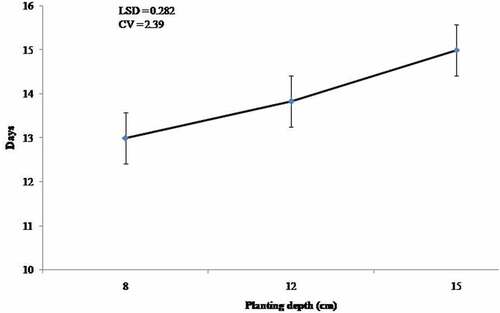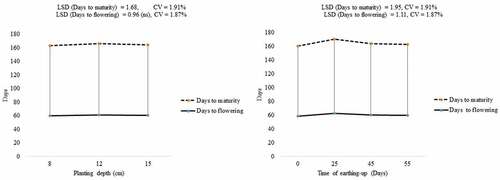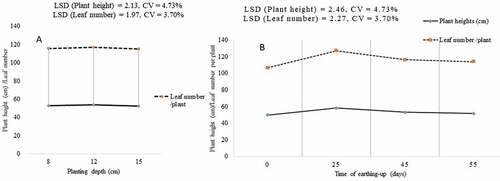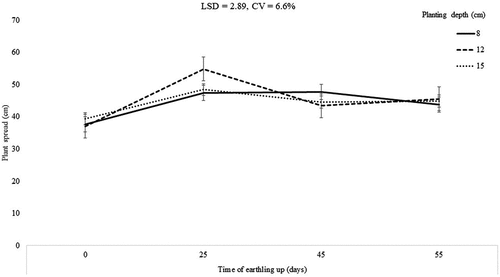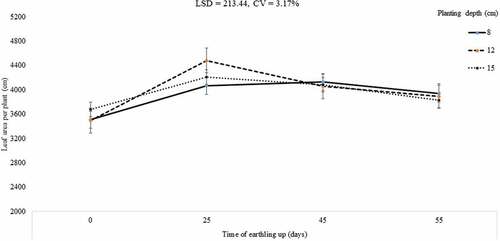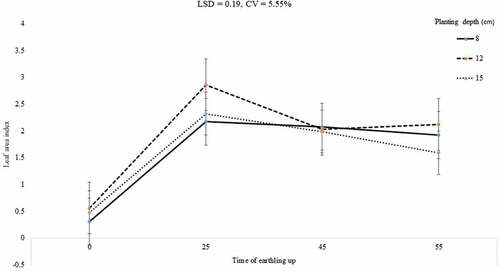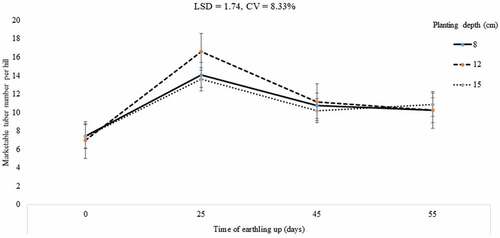Abstract
Potatoes are one of the most important vegetable crops which play an important role in improving household income and nutrition thereby contributing to food security in smallholder farmers. However, yield and productivity of the crop have been far below the world average. The present study was, therefore, undertaken to improve the productivity and quality of potato through proper planting depth and time of earthing up under supplemental irrigation using Jalane variety. The result revealed that days to flowering, days to physiological maturity, plant height, leaf number per plant, number of main stem per plant, unmarketable tuber number, marketable tuber yield, unmarketable tuber yield, total tuber yield, dry matter content, size category and specific gravity were significantly different due to the main effects of planting depth and time of earthing up. Interaction effect of planting depth and time of earthing up significantly affected the yield and quality of potato plants. The highest marketable and total tuber yield was recorded from the earthing up at 25 days after emergence using 12 cm depth of planting. The result may give firsthand information for potato producers to maximize their productivity. The production of potato is improved through the combination of 12 cm planting depth and earthing up at 25 days after emergence.
PUBLIC INTEREST STATMENT
In a time of extremely high population growth, loss of arable land and climate change effects, the food security issue is becoming more and more serious. Potatoes are considered as one of the most productive food crops in terms of yields of edible parts and good quality protein per unit area per unit time. It is also regarded as a high potential food security crop because of its high productivity and quality per unit input with a shorter crop cycle. It is from this background that the researcher tried to investigate the production and productivity of potato by improving the most important agronomic practices. The findings showed the highest yield and quality response of potato tubers from the earthling up at the 2nd week after emergence using medium level of planting depth. In the end, appropriate recommendations have been forwarded in this paper for the small-scale and commercial potato producers.
1. Introduction
Potato (Solanum tuberosum L.) is one of the most productive food crops in terms of yields of edible energy and good quality protein per unit area per unit time (Jessie, Citation2017). The annual world and African production of potato during 2018 was about 368.2 and 26 million tons, respectively (FAO, Citation2020). Ethiopia is one of the principal potatoes producing countries in Africa and probably displays a unique position for having the highest potential area for cultivating potatoes. It is grown by approximately one million smallholder farmers in central, eastern, northwestern and southern highlands of Ethiopia. About 9.245 million tons of potato are produced from 70,362 ha during 2019/20 cropping season (FAO, Citation2020).
Potato is one of the major staple crops in the Eastern and Central Africa sub-region and its importance continues to rise due to increased urbanization and uptake of processed potato products such as French fries (chips) and crisps (Wassihun et al., Citation2019). Demand for potatoes in sub-Saharan Africa is projected to have a 250% increase between 1993 and 2020, with an annual growth in demand of 3.1% and the growth in area under production is estimated at 1.25% a year (Scott et al., Citation2000). It also has a huge potential to contribute to the national economy, improve food security and income for smallholder farmers through its value-added products (Tiruneh et al., Citation2017). Potato is also one of the most important cash crops to improve food security and reduce poverty among smallholder farmers in developing countries. On the contrary, in small-scale farms, the production levels of potato are stagnated at about 9.245 million tons, which was far below the continental average of 26 million tons in Africa (FAO, Citation2020). The low production and productivity of potato in Ethiopia is due to the use of suboptimal amounts and types of fertilizers, substandard quality tubers, and inappropriate depth of planting and time of earthing-up (Samuel, Citation2017).
Earthing-up influences numbers and sizes of potato stolons, and the structure of the stolon system (Chala, Citation2016). Gutema (Citation2016) also obtained an increased tuber yield by 10–20% compared to the control from earthing up at early days after emergence. This is largely because the earthing up coincides with its active growth stage; hence improved soil conditions at this stage promote efficient nutrient absorption resulting in increased plant growth and development that ultimately results in higher tuber yield (Fanos et al., Citation2015). According to Getachew et al., Citation2013) early stages of earthing up in potato create a suitable environment for growth of stolons and promotes more tuber initiation.
Potato yield is also greatly influenced by depth of seed tubers (Singh et al., Citation2020). Sayed et al. (Citation2013) note that, to obtain a homogeneous culture, the tubers should be distributed in a uniform planting depth. Potato is often unable to exploit nutrients and water from deep soil depth due to its shallow root system. Kumar et al. (Citation2015) also noted that, to reduce the percentage of green tubers, accurate planting depth of seed potatoes is of great importance.
Improving the production and productivity of potato crop can help to match the four dimensions of food security, i.e. food availability, food access, food use and quality, and food stability due to its range of distribution pattern, and its today’s production and demand, principally in developing world where poverty, hunger, and malnutrition ensues (Jasim et al., Citation2020). Potato tuber is improved through determining the depth of planting and time of earthing-up (Tesfaye et al., Citation2012). Masvodza (Citation2015) also reported that time of earthing up and depth of planting are the most important for improving productivity and quality of potato. Therefore, the current study was conducted to improve the production and productivity of potato tubers through the proper planting depth and time of earthing-up and thereby contributes for food security in smallholder farmers.
2. Materials and methods
2.1. Description of the study area
The experiment was conducted at Homa Kebele Farmers Training Center (FTC) field in Hedero Tunto Zuria Woreda, Kembata Tembaro Zone in Southern Ethiopia at an altitude of 225 m above sea level with a latitude of 7.12° N and longitude of 37.44° E. Average annual rainfall of the area was 800 mm with a range of 900 mm to 1100 mm and the average annual minimum and maximum temperatures of 16 and 26°C, respectively. The soil is a clay loam. The area has mono-modal rainfall.
2.2. Experimental materials, treatment and design
Potato seed tuber “Jalene” was collected from a farmers’ cooperative. The variety was selected based on its high yield potential and adaptation. A factorial combination of planting depths of 8, 12 or 15 cm and earthing-up after emergence of 0, 25, 45 and 55 days were arranged in randomized complete block design with 3 replications. A uniform plot size of 3 × 3 m was used for each unit with a total experimental area of 324 m2.
Healthy, well-sprouted medium-size (45–50 g) tubers of “Jalene” were used. The experimental field was plowed four times by oxen before planting. Ridges were prepared with a spacing of 75 × 30 cm between rows and plants, respectively, before planting. There were four rows per plot and 10 plants in each row with a total of 40 plants per plot. Uniformly sprouted (3 to 4) medium-sized tubers, 45–50 g, were planted manually. Earthing-up was done based on the treatment. Recommended nitrogen fertilizer in the form of urea and blended NPS was applied uniformly for all plots. The recommended amount of 236 kg ha−1 NPS was applied at planting; 165 kg ha−1 of Urea (Anonymous, 2004) was applied in two splits (1/2 at planting and 1/2 at mid-stage of the plant: about 40 days after planting). Ridomil MZ 63.5% WP® at the rate of 2 kg ha−1 and Mancozeb® at the rate 3 kg ha−1 was applied to control late blight.
2.3. Data collection
Data was collected from the two middle rows. Haulms were removed 2 weeks before harvesting to thicken the tuber periderm when plants reached physiological maturity. For yield estimation, tubers were harvested from plants grown in the two middle rows. Harvesting was done using hand held tools when leaves of 70% of the plants turned yellowish and showed signs of senescence.
2.3.1. Phenological and growth parameters
Days to emergence, flowering and maturity were recorded when 50% of tubers emerged and produced flowers and when 90% of plants in each plot were ready for harvest, respectively. Plant height was measured from five randomly selected plants in each plot at 50% flowering. Number of leaves per hill was determined by counting the number of leaves in each hill. Leaf area was determined with a leaf area meter and leaf area index determined by dividing the leaf area by the ground area.
2.3.2. Yield and quality parameters
Marketable tuber yield was measured by selecting average weight of tubers free from diseases, insect pests and above 20 g from the two central rows and the rest was recorded as unmarketable tuber yield. Total tuber yield was determined by adding weights of marketable and unmarketable tubers. Total tuber number/hill was determined by adding the number of marketable and unmarketable tubers per hill. The proportional number of tuber size categories and tuber dry matter content (%) and specific gravity were measured based on the methods developed by Anonymous (2007).
2.4. Data analysis
The data were subjected to analysis of variance using the General Linear Model in SAS software and mean separation was made based on LSD at 5% level of significance.
3. Results and discussion
3.1. Days to emergence
The analysis of variance showed that planting depth significantly (P ≤ 0.001) affected the number of days taken for the crop to emerge. Increasing the depth of planting from 8 to 15 cm progressively delayed the emergency of the potato plant (Figure ). The earliest days to emergence were recorded at 8 cm planting depth days. Whereas, emergence days were delayed in 15 cm planting depths by 15 days (Figure ). Rapid emergence allows plants to capture solar radiation early, thereby optimizing final tuber yield and dry-matter content (Firman et al., 1989). The fact that emergence was typically delayed as planting depth increased due to temperature variability across the field and soil depth (Pavek & Thornton, Citation2009). Additionally, the potato sprouts had to come across a longer distance of the ground to emerge than the shallow planting. The different soil depths are different soil temperatures that delay or hasten the emergency. The results are also in agreement with findings of Sultana et al. (Citation2001) who verified that plant emergence was occasionally delayed with an increase in planting depth.
3.2. Days to flowering
Significant (P ≤ 0.05) differences were observed in days to flowering to the effect of time of earthing-up. However, planting depth and its interaction effect with time of earthing-up was not significantly (P > 0.05) different. Days to flowering were delayed earthing-up at 25 days after emergence. The earliest flowering was observed on the control treatment (Figure ). Absence of earthing-up avoids the presence of a physical barrier for sprout to emerge that resulted in early flowering. Early flowering is also related with days to emergence; potatoes which emerged earlier flower earlier than those emerged later. This result is in agreement with the findings of Tesfaye et al. (Citation2012) who reported prolonged flowering when potatoes were earthing-up at 25 days after complete plant emergence.
3.3. Days to maturity
Days to maturity were significantly (P ≤ 0.001) affected by the main effects of time of earthing up and planting depth. However, the interaction effect had no significant effect. The maturation period for potatoes varied depending on time of earthing-up and planting depth. Maturity was delayed at 12 and 15 cm planting depth (Figure ). Earthing-up at 25 days after emergence delayed maturity of potato as compared to other treatments (Figure ). In agreement with the current findings, Tesfaye et al. (Citation2012) also reported that earthing-up at 25 days delayed days to maturity of potato.
3.4. Plant height
Plant height was significantly (P ≤ 0.05) influenced by the main effect of time of earthing-up. However, the main effects of planting depth and its interaction did not show significantly different results. The longest plant height was recorded from 25 days of earthings-up. Whereas, the shortest (50 cm) plant height was recorded from a non-earthing-up plot. Earthing-up at 25 days after emergence increased plant height by 8 cm compared to no earthing up treatment (Figure ). This might be due to moisture and nutrient use efficiency provided from the mound of soil around the root while earthing up. The result is inconsistent with the finding of Qadir and Ali (Citation1999) who confirmed significantly higher plant height from earthing up after two weeks of emergency. In agreement with the current result, Tesfaye et al. (Citation2012) also reported that early soil cultivation (earthing-up) facilitated the nutrient absorption through enhanced microbial processes and increased soil aeration.
3.5. Leaf number/hill
Number of leaves per plant was highly and significantly (P ≤ 0.05) affected by time of earthing up. However, the depth of planting and interaction of planting depth and time of earthing up were found to be non-significant. Plants produced the highest number of leaves when earthing up was done 25 days after emergence (Figure ). During the expansion phase, the leaf imports carbon and nitrogen and undergoes rapid protein synthesis until its full capacity to photosynthesize is reached (Buchanan-Wollaston, Citation1997).
3.6. Plant spread
Plant spread was significantly (P ≤ 0.001) influenced by the interaction effects of planting depth and time of earthing-up. The widest plant spread was recorded from 12 cm planting depth with earthing up at 25 days after emergence. The narrowest plant spread was recorded from non-earthing up is combined with 8 and 12 cm planting depth (Figure ). This could be due to the fact that earthing-up at 25 days after complete plant emergency could coincide with the proper time of soil workability and optimum soil moisture level. This made the soil porous, aerated and the plant received the advantage of proper growth and development. At shallow planting, the length of plant spread decreased in all tested times of earthing up. One reason may be due to earthing up provided soil around the root zone which provided enough nutrients to the plants and also due to the favorable environment provided to the plants leading to good emergence and healthier plants. Similarly, Tesfaye et al. (Citation2012) also reported that, earthing up at 25 days after full plant emergency, there was widest plant spread.
3.7. Leaf area
Potato leaf area per plant was significantly (P ≤ 0.01) affected by both time of earthing up and interaction effect of planting depth and time of earthing up. However, the depth of planting was found to be non-significant. The largest leaf area was recorded at 12 cm depth of planting with 25 days earthing up. Earthing up 25 days after emergence resulted in early emergence and produced a large number of leaves as mentioned earlier (Figure ). These may give sufficient time for utilizing available resources and contributed for the growth of the plant and production of a large leaf area.
At 12 cm planting depth and 25 days’ time of earthing-up provided optimum soil porosity and aeration, that plants absorbed available resources sufficiently and increased their photosynthetic efficiency that further increased the vegetative growth and ultimately resulted in increased leaf area. Oliveira (Citation2000) confirmed that leaf area decreased in non-earthing up compared to different stages of earthing-up that resulted in the largest leaf area. Earthing-up at 25 days after complete plant emergence coincided with the active growth stage of the plant improved the soil porosity and aeration, better root growth and penetration for nutrient absorption, increased plant growth and development that ultimately increased leaf area.
3.8. Leaf area index (LAI)
Leaf area index was significantly (P ≤ 0.01) affected by the interaction effects of time of earthing-up and planting depth. The largest leaf area index was recorded at 12 cm depth of planting with earthing-up at 25 days after emergence (Figure ). While the smallest leaf area index was recorded at the combination of non-earthing-up with 8 and 15 cm planting depth (Figure ). Leaf area index represents the relationship between plant photosynthesizing area and its projection in the soil, varying with leaf shape and both vertical and horizontal foliage distribution. A maximum LAI may be related to the greatest assimilate distribution from the leaves to the tubers; meanwhile a lower LAI could ensure a higher exposure of the remaining leaves to photosynthetically active radiation (PAR), securing a greater photosynthetic efficiency. Besides, this indicator is widely used to show aerial part architecture (Tekalign & Hammes, Citation2005).
3.9. Total number of tubers
Total tuber number per hill was significantly (P ≤ 0.01) affected by the main and interaction effect of planting depth and time of earthing-up. The highest total tuber number was recorded from earthing up at 25 days after emergency and 12 cm depth of planting. While, the minimum number of total tuber numbers per hill were recorded from non earthing-up combined with all planting depth (Figure ). Tafi et al. (Citation2010) reported that adding soil to the potato plant increased significantly and attributed the increased dry matter accumulation.
Figure 7. Interaction effects of depth of planting and time of earthing-up on total tuber number/hill of potato.
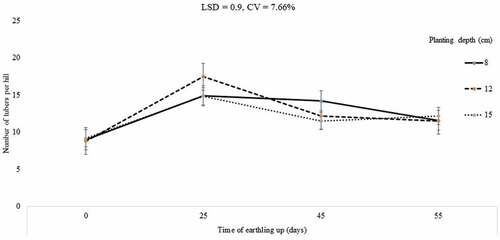
Chala (Citation2016) also pointed out that, riding at two weeks after emergence during the growing period increased tuber yield by 10–20% compared to the control. In addition, Fanos et al. (Citation2015) also obtained that earthing-up at 25 days gives a difference of 10.13% on total potato tuber yield over the control with non earthing-up. This study is also linked with Harder that totally planting depth and method of farming, soil temperature and humidity around the tubers grown has a significant effect on the total number of tubers. In conformity to our result, Tafi et al. (Citation2010) reported adding soil increase tuber numbers per bush. Moreover, Kumar et al. (Citation2015) showed that early stage earthing-up can create favorable conditions for potatoes to produce a large number of tubers.
3.10. Unmarketable tuber number per hill
The analysis of variance indicated that the main effects of time of earthing up had a highly significant (P ≤ 0.05) effect on unmarketable tuber number, while depth of planting and interaction effect was non-significant. The non-earthing plants had the highest number of unmarketable tuber numbers per hill (Table ). Svubure et al. (Citation2015) showed that exposing tubers outside of hill or tubers are shallow, less than 5 cm covered by soil make tubers prone to pest attack and greening which compromises tuber quality. This may be due to the fact that planting when there is no earthing up, plants will have no enough room for the production of sizeable tubers and the also the tubers will be exposed to environmental factors which led to produce high number of under size tubers, green, insect attached and defective tubers.
Table 1. Effects of planting depth and time of earthing up on unmarketable tuber number per plant, marketable tuber yield, unmarketable yield and total tuber yield of potato
3.11. Unmarketable tuber yield
Unmarketable tuber yield was highly significantly (P ≤ 0.05) affected by time of earthing-up, however, planting depth and interaction effect between planting depth and time of earthing up were non-significant. The highest unmarketable tuber yield was recorded from control treatment and it was lowest in the other earthing up treatment (Table ). Results of this experiment revealed that non earthing-up resulted in a higher percentage of unmarketable tubers. Kumar et al. (Citation2015) show that improper soil depth causes deficiency of soil moisture and increases the attack of cutworms and mites. Low soil moisture also increases formation of cracks in the soil, which allow the entry of potato tuber moth and its larvae. The misshaped tuber could be formed due to soil depth temperature difference. The result was also in agreement with the findings of Krystyna (Citation2013) who reported that high temperature during early stages of tuber development caused lower percentage of misshapen tubers.
3.12. Total tuber yield
Total tuber yield was highly significantly (P ≤ 0.05) influenced by time of earthing-up, however planting depth and interaction effect between planting depth and time of earthing up were not significant. The highest total tuber yield was recorded from earthing up at 25 days after emergency; whereas, it was lowest from no earthing up treatment (Table ). This result is in line with the study of Tafi et al. (Citation2010) who reported the advantage of the soil adding on the yield characteristics of potato. Adding soil increased tuber yield significantly compared to non-adding soil which led to improvement of total yield. Majid and Roza (Citation2011) reported that time and depth of soil soiling had a significant effect on the percentage of potato yield per unit area. Earthing up increases the soil around the root that conserves moisture and creates a suitable environment for growth of tubers. In the same way, the presence of a high number of stems per unit area which is attributed to the production of many stems leads to the production of high number of tubers and consequently high total tuber yield per hectare (Sanli et al., Citation2015).
3.13. Marketable tuber yield
Marketable tuber yield was significantly (P ≤ 0.05) affected by time of earthing-up, however, planting depth and its interaction effect had no significant effect on marketable tuber yield. The highest marketable tuber yield was recorded from earthing up at 25 days after full emergence (Table ). Non earthing-up plots resulted in the lowest marketable tuber yield. Earthing up at 45 and 55 days after emergence were statistically similar. Proper earthing not only increases yield but also improves marketable tuber quality. Similarly, Tesfaye et al. (Citation2012) reported that proper time of earthing up could improve the soil conditions for proper root growth and nutrient absorption that facilitate the above ground part for better growth and development ultimately resulting in the better marketable tuber yield. At the right time of earthing-up can produce conditions for the plant that were good aeration, moisture movement, and soil condition to absorb nutrients and water during this active growth stage.
3.14. Marketable tuber number per hill
Marketable tuber number per hill was highly significantly (P ≤ 0.01) affected the time of earthing-up. This parameter was also significantly (P ≤ 0.05) influenced by the main effect of time of earthing up and its interaction effect. However, the depth of planting is not significant. The highest marketable tubers number was obtained from 12 cm planting depth and at 25 days of earthing up (Figure ). However, the lowest marketable tubers number was obtained from the control plots (no earthing up) with all planting depths (Figure ). Even though early earthing-up was superior when compared to very late earthing-up and no earthing-up with regard to different parameters, however no earthing-up and shallow planting depth performed very poorly (Fanos et al., Citation2015). Results from Selman et al. (Citation2008) and Majid and Roza (Citation2011) also showed that potato tuber exposure to light in the field causes the formation of a green pigmentation. This occurs when sunlight directly contacts tubers growing at or near the soil surface or reaches tubers through cracks in the soil surface. Early development below ground morphology, tuber expansion, yield and tuber quality are among the aspects affected by planting depth (Pavek & Thornton, Citation2009).
3.15. Size categories of tubers
The analysis of variance showed that the main effect of time of earthing up had a significant (P ≤ 0.05) effect on small, medium and large tuber size parameters. However, planting depth and interaction effect of planting depth and time of earthing up for small, medium and large size of tubers were not significant. The highest number of tuber size was recorded in large and medium tubers size distribution at 25 days’ time of earthing up, also the highest number of small tuber size recorded in control treatment. Tuber size is an increasingly important aspect of potato physical quality. This is because potatoes are marketed according to specific quality attributes that include tuber size (Table ). The size distribution of harvested crop is one of the factors determining its economic value and specific grades are required for specific market outlets and purposes (Devaux et al., Citation2014). Most consumers require big size potatoes since large tubers are required for processing, while medium sized tubers are preferred for home consumption and the small ones are often used by the farmers for seed and home consumption (Govinden, Citation2006).
Table 2. Effects of planting depth and time of earthing up on dry matter content, specific gravity and tuber size category of potato tuber
3.16. Specific gravity
Time of earthing-up significantly (P<0.05) affected specific gravity of potato. However, planting depth and the interaction effects of planting depth and time of erthing-up had no significant effect on specific gravity. The highest specific gravity was recorded from 45 and 55 times of earthing up and the lowest was recorded from 25 days. This might be due to the fact that later earthing-up protect the tuber from the adverse conditions that better keep the quality of the tuber at best potential. However, such characters are mainly affected by genetic factor (Table ). Like any other quality attribute, genotype has a decisive effect in determining the specific gravity. Rykbost and Maxwell (Citation1993) reported that plant population did not have an effect on the specific gravity of all the varieties they studied.
3.17. Dry matter content
Dry matter content of potato tubers was highly significantly (P ≤ 0.05) affected by time of earthing-up. However, the planting depth and interaction between depth of planting and time of earthing-up were non- significant. Significantly highest dry matter content was recorded at earthing-up at 25 days after full emergence followed by the earthing-up at 45 days after full emergence, while the lowest dry matter concentration was from the non-earthing-up (Table ).
Earthing-up at 25 days after full emergence increased dry matter content by 5.06% compared to that of non-earthing after full emergence. Generally, earthing-up at appropriate time improves dry matter concentration. This might be due to moisture and nutrient provision on the proper earthing-up practices. In agreement with the current result, Tesfaye et al. (Citation2012) reported early soil cultivation (earthing-up) facilitated the nutrient absorption through enhanced microbial processes and increased soil aeration. Kabira and Berga (2006) reported that tuber dry matter contents of more than 20% are acceptable for processing of chips and crisp. The dry matter concentration found on proper earthing-up can satisfy the requirement for processing. Tesfaye et al. (Citation2012) also reported that potato tuber with dry matter concentration greater than 20% is the most preferred for processing of tuber into different potato products.
Availability of data and materials
We, the authors of this manuscript, would like to confirm that all raw data will be available with a reasonable request.
Acknowledgements
The authors thank Hawassa University and Kembata Tembaro Zone administrative office for facilitating administrative issues to undertake this experiment.
Disclosure statement
No potential conflict of interest was reported by the author(s).
Additional information
Funding
Notes on contributors
Mulugeta Doboch
Mulugeta Doboch is MSc. in Horticulture serving as an expert of horticulture in the Ministry of Agriculture and Natural resource. He contributed to the production and improvement of Horticultural crops. He is interested in horticulture and agronomy.
Andargachew Gedebo
Andargachew Gedebo is an Associate Professor of Plant Breeding and Agronomy at Hawassa University, Ethiopia. He had BSc in Crop Science and MSc in Crop Physiology both from Reading University, UK; and PhD in Agriculture from Norwegian University of Life Sciences, Norway. He has more than 20 years of teaching and research experience in the area of crop physiology, agronomy and plant breeding. He published more than 20 research papers in international journals. He is interested in breeding, agronomy and physiology of field and horticultural crops. He was involved in different curricular activities and worked as a coordinator of different projects.
Ashenafi Haile
Ashenafi Haile is an assistant professor of Horticulture in Hawassa University, Ethiopia. He has more than 13 years of teaching, research and community services experience in the area of Horticulture. He has more than 15 published and unpublished research works and practical manuals in his area of specialization. He is interested in climate change, food security and Horticulture Agronomy and physiology.

Hussien Mohammed Beshir
Hussien Mohammed Beshir is an Associate Professor of Horticulture/Plant Physiology in Hawassa University, Ethiopia. He has more than 15 years of teaching and research experience in the area of Horticulture. He was involved in curriculum development/evaluation, teaching, student supervision and research in Horticulture in different National Universities in Ethiopia.
References
- Buchanan-Wollaston, V. (1997). The molecular biology of leaf senescence. Journal of Experimental Botany, 48(2), 181–13. https://doi.org/10.1093/jxb/48.2.181
- Chala, G. (2016). Effect of earthing up frequencies and tuber seed form on yield and profitability Of Potato (Solanum tuberosum L.) production in Bale Highlands. Agricultural Research and Technology Open Access Journal, 2(4), 96–100. https://doi.org/10.19080/ARTOAJ.2016.01.555592
- Devaux, A., Kromann, P., & Ortiz, O. (2014). Potatoes for sustainable global food security. Potato Research, 57(3–4), 185–199. https://doi.org/10.1007/s11540-014-9265-1
- Fanos, T., Belew, D., & Nebiyu, A. (2015). Effect of planting depth and time of earthing-up on Potato (Solanum tuberosum L.) yield and yield components at Jimma University College of Agriculture and Veterinary Medicine, South West Ethiopia. International Journal of African and Asian Studies, 15, 61–78. https://iiste.org/Journals/index.php/JAAS/article/view/27057/27740
- FAO. (2020). FAOSTAT Database collection. Food and Agriculture Organization of the United Nations.
- Fekadu, M., & Gelmesa, D. (2006). Review of the status of vegetable crops production and marketing in Ethiopia. Uganda Journal of Agricultural Sciences, 12(2), 26–30.
- Firman, D. M., Brien, P. J. O., & Allen, E. J. (1992). Predicting the emergence of potatosprouts. J. Agri. Sci, 118(1), 55–61. https://doi.org/10.1017/S0021859600068003
- Getachew, T., Belew, D., & Tulu, S. (2013). combined effect of plant spacing and time of earthing up on tuber quality parameters of potato (solanum tuberosum l.) at degem district, north showa zone of oromia regional state. Asian Journal of Crop Science, 5(1), 24–32.
- Govinden, N. (2006). Potato tuber characteristics preferred by growers. Research Institute Food Crop Agronomy Department, occasional report 34. Mauritius Sugar Industry.
- Gutema, C. (2016). Effect of earthing up frequencies and tuber seed form on yield and profitability of potato (solanum tuberosum l.) production in bale highlands. agricultural research & technology. Open Access Journal Is Currently Edited by Sophia Mathis, 2(4), 96–101.
- Jasim, A., Sharma, L. K., Zaeen, A., Bali, S. K., Buzza, A., & Alyokhin, A. (2020). Potato Phosphorus Response in Soils with High Value of Phosphorus. Agriculture, 10(7), 264. https://doi.org/10.3390/agriculture10070264
- Jessie, S. (2017). Potatoes: Health Benefits. Risks and Nutrition Facts: Live Science.
- Kabira, J. N., & Berga, L. (2003). Potato processing quality evaluation procedures for research and food industry applications in East and Central Africa. Kenya Agricultural Research Institute.
- Krystyna, R. (2013). Assessment of Potato mother tuber vigour using the method of accelerated ageing. Plant Production and Science, 16(2), 171–182. https://doi.org/10.1626/pps.16.171
- Kumar, P., Singh, S., Kumar, R., Rawal, S., & Singh, B. P. (2015). Effect of tuber planting depth on yield, quality and profitability of potato (Solanum tuberosum L.) processing varieties. Indian Journal of Agronomy, 60(1), 139–144. https://indianjournals.com/ijor.aspx?target=ijor:ija&volume=60&issue=1&article=023
- Laei, G. H., Noryan, M., & Afshari, H. (2012). Determination of the planting depth of potato seed tuber yield and yield components of two varieties agria and draga response curves seed. Scholars Research Library Annals of Biological Research, 3(12), 5521–5528.
- Majid, K., & Roza, L. (2011). Effects of planting depth and soiling time of the plant foot on the potato yield. African Journal of Agricultural Research, 6(16), 3804–3808. https://doi.org/10.5897/AJAR11.180
- Masvodza, R. (2015). Feasibility of sack Potato production as a new technique used in some urban parts of Zimbabwe. Journal of Agriculture and Ecology Research International, 2(3), 201–208. https://doi.org/10.9734/JAERI/2015/13700
- Muhammad, Q., Salma, K., Alia, N., Muhammad, Z., & Sohailahmad, K. (2013). Effects of different planting systems on yield of potato crop in kaghan valley: A mountainous region of Pakistan. Agricultural Sciences, 4(4), 175–179. https://doi.org/10.4236/as.2013.44025
- Oliveira, C. A. D. S. (2000). Potato crop growth as affected by nitrogen and plant density. Pesq. Agropec. Bras, 35(5), 939–950. https://doi.org/10.1590/S0100-204X2000000500011
- Pavek, T., & Thornton, S. (2009). Planting depth influences potato plant morphology and economic value. American Journal of Potato Research, 86(1), 56–67. https://doi.org/10.1007/s12230-008-9062-y
- Qadir, G. M., & Ali, I. (1999). Effect of earthing-up at different stages of growth on yield of potato cultivar cardinal under the soil and climatic condition of Peshawar. Pakistan Sarhad Journal of Agriculture, 15, 423–425. https://agris.fao.org/agris-search/search.do?recordID=PK2001000010
- Rykbost, K. A., & Maxwell, J. (1993). Effects of plant population on the performance of seven varieties in the Klamath Basin of Oregon. American Potato Journal, 70(6), 463–474. https://doi.org/10.1007/BF02849065
- Samuel, S. (2017). Effect of Combined Application of Biochar and Inorganic Nutrients (N and P) on Yield and Yield Components of Potato (Solanum tuberosum L.) at Gecha, Andiracha District, South western Ethiopia. MSc thesis Submitted to School of Graduate studies, Jimma University.
- Sanli, A., Karadogan, T., Erbas, S., & Tosun, B. (2015). The effects of plant density and eye number per seed piece on potato (Solanum tuberosum L.) tuber yield. Scientific Papers, Series A. Agronomy, 8, 325–331.
- Sayed, A. H., Tu, S. Y., Chen, J., Zhao, X., & Towfic, Z. J. (2013). Diffusion strategies for adaptation and learning over networks: An examination of distributed strategies and network behavior. IEEE Signal Processing Magazine, 30(3), 155–171. https://doi.org/10.1109/MSP.2012.2231991
- Scott, J. S., Rosegrant, M. W., & Ringler, C. (2000). Roots and tubers for the 21st century: Trends, projections and policy options. Food, Agriculture and the Environment Discussion Paper 31, pp 64. http://www.ifpri.org/sites/default/files/publications/2020dp31.pdf
- Selman, N., Andrews, A., Stone, A., & Mosley, A. (2008). What’s wrong with my Potato tubers? Diagnosing tuber abnormalities in western Oregon and Washington. In Oregon State University Extension EM 8948-E. https://catalog.extension.oregonstate.edu/sites/catalog/files/project/pdf/em8948.pdf
- Singh, N., Amandeep, S., & Kanwaljit, S. (2020). Effect of Depth of Tuber Planting on Growth and Yield Parameters of Potato Crop. International Journal of Current Microbiology and Applied Science, 9(5), 2504–2507. https://doi.org/10.20546/ijcmas.2020.905.286
- Sultana, N., Bari, M. S., & Rabbani, M. G. (2001). Effect of seedling tuber size and depth of planting on growth and yield of Potato. Pakistan Journal of Biological Science, 4(10), 1205–1208. https://doi.org/10.3923/pjbs.2001.1205.1208
- Svubure, O., Struik, P. C., Haverkort, A. J., & Steyn, J. M. (2015). Yield gap analysis and resource footprints of Irish potato production systems in Zimbabwe. Field Crops Research, 178, 77–90. https://doi.org/10.1016/j.fcr.2015.04.002
- Tafi, S., Siyadat, R., Radjabi, K., & Mojadama, M. (2010). Effects of earthing up on the potato yield in Dezful (Khouzestan, Iran) Weather Condition. Middle-East Journal of Scientific Research, 5(5), 392–396. http://www.idosi.org/mejsr/mejsr5(5)/13.pdf
- Tekalign, T., & Hammes, Y. P. S. (2005). Growth and productivity of potato as influenced by cultivar and reproductive growth: II. Growth analysis. Tuber Yield and Quality. Scientia Horticulturae, 105(1), 29–44. https://doi.org/10.1016/j.scienta.2005.01.021
- Tesfaye, G., Derbew, B., & Solomon, T. (2012). Combined Effect of Plant Spacing and Time of Earthing up on Tuber Quality Parameters of Potato (Solanum tuberosum L.) at Degem District, North Showa Zone of Oromia Regional State. Asian Journal of Crop Science, 5(1), 24–32. https://doi.org/10.3923/ajcs.2013.24.32
- Tiruneh, W. G., Chindi, A., & Woldegiorgis, G. (2017). Technical efciency determinants of potato production: A study of rain-fed and irrigated smallholder farmers in Welmera district. Oromia, Ethiopia. Journal of Development, Agriculture and Economics, 9(8), 217–223. https://doi.org/10.5897/JDAE2016.0794
- Wassihun, A. N., Koye, T. D., & Koye, A. D. (2019). Analysis of technical efficiency of potato (Solanum tuberosum L.) production in Chilga District, Amhara National Regional State, Ethiopia. Economic Structures, 8(34), 1–18. https://doi.org/10.1186/s40008-019-0166-y

